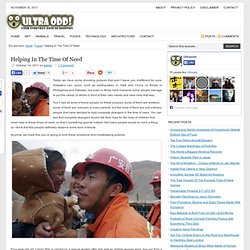

Hi Noroshi. Natural disasters and extreme weather. Natural disasters? At least since Noah, and likely long before, we've stared in horror at catastrophe and tried to suss out deeper meaning – it was but weeks ago that the Tokyo governor, Shintaro Ishihara, declared that the earthquake/tsunami/ reactor tripleheader was "divine punishment" for excess consumerism.

This line of reasoning usually fails to persuade these days (why are Las Vegas and Dubai unscathed by anything except the housing meltdown?) But it's persistent. We need some explanation for why our stable world is suddenly cracked in half or under water. Still, over time we've become less superstitious, since science can explain these cataclysms. Angry gods or plate tectonics? Which is odd, because the physical world is moving in the other direction. The Holocene – the 10,000 years through which we have just come – was by all accounts a period of calm and stability on Earth.
In a sense Ishihara was correct when he decried "selfish greed". That changes the valence of catastrophe. Japan earthquake. Helping In The Time Of Need. Today we have some shocking pictures that won’t leave you indifferent for sure.

Disasters can occur, such as earthquakes in Haiti and China or floods in Philippines and Pakistan, but even in those hard moments some people manage to put the needs of others in front of their own needs and save lives that way. You’ll see all sorts of brave people on these pictures, some of them are soldiers, some of them are rescuers or even parents, but the most of them are just ordinary people that have decided to help complete strangers in the time of need. You can see that complete strangers would risk their lives for the lives of children that need help in these times of need, so that’s something special indeed. Not many people would do such a thing, so I think that this people definitely deserve some kind of tribute. Anyhow, we hope that you’re going to love these emotional and breathtaking pictures. U.S. Men carry an injured woman near a clinic on January 13, 2010 in Port-au-Prince, Haiti. An Epoch in the making. We may be witnessing a transformation of the Earth as profound as the end of the age of the dinosaurs, and entering a geological period as distinctive as the Jurassic - and the reason is that we are causing it.

Writing in the house journal of the Geological Society of America, GSA Today, Britain's leading stratigraphers (experts in marking geological time) say it is already possible to identify a host of geological indicators that will be recognisable millions of years into the future as marking the start of a new epoch - the Anthropocene. Geologists have long divided the Earth's history into distinct epochs, periods and eras - with names as familiar as the Triassic or the Carboniferous. Transitions between them can be easily recognised, with sharp changes in the fossil record, or in the chemistry of the rocks of the time. Sometimes the boundaries mark extreme violence. A force of nature There can also be soot - the result of global wildfires that followed the catastrophe.
Five snapshots of people in crisis. 1,2 million de victimes et 1000 milliards de dollars de dommages. Au cours de la dernière décennie, les catastrophes naturelles ont fait en moyenne 124 423 morts par an.

Ce chiffre cache cependant une forte variabilité interannuelle puisqu’il existe une différence de facteur 32 entre l’année la moins meurtrière (2009 avec 11852 morts) et celle où l’on déplore le plus grand nombre de victimes (2010 avec 391017 morts). Les années ayant les plus lourds bilans humains (2004, 2005, 2008 et 2010) sont celles durant lesquelles un ou plusieurs événements majeurs (tsunami en Indonésie en 2004, séisme au Pakistan en 2005, cyclone Nargis en Birmanie et séisme en Chine en 2008, séisme en Haïti et canicule en Russie en 2010).
Avec 576 474 morts, les séismes représentent 46 % des victimes liées aux catastrophes naturelles de la décennie écoulée. Les tsunamis viennent en seconde position avec 271 775 morts (22 % du total), suivis par les cyclones et tempêtes tropicales qui ont causé la mort de 229 037 personnes (18,4 % du total). Trends in natural disasters - Maps and Graphics at UNEP/GRID-Arendal. The GRID-Arendal Maps & Graphics Library is an on-going project to collect and catalogue all graphic products that have been prepared for publications and web-sites from the last 15 years in a wide range of themes related to environment and sustainable development.

There are currently 3022 graphics available in the database. Urban growth rate in Africa Africa’s urban centres are currently growing at an annual rate that is the fastest compared to other regions. The urban expansion is expected to continue, with cities like Abuja and Ouagadougou expecting very high growth in the next decade, while Cairo, Africa’s largest city, is projected to see a comparatively lower growth rate. 27 Feb 2011 - by Riccardo Pravettoni, UNEP/GRID-Arendal Forest Carbon Sequestration Converting land for biofuel production can cause biodiversity impacts in the short-term, but such conversion also a ects the future resilience of natural ecosystems.